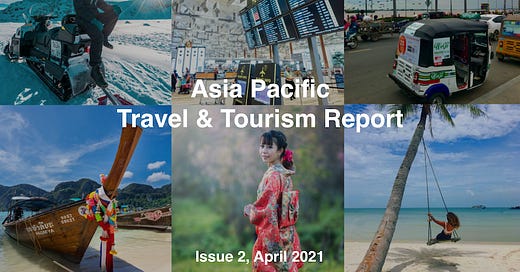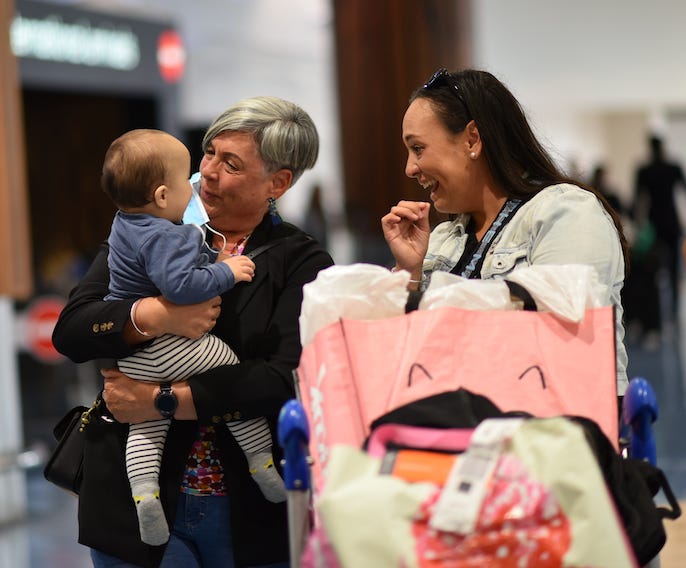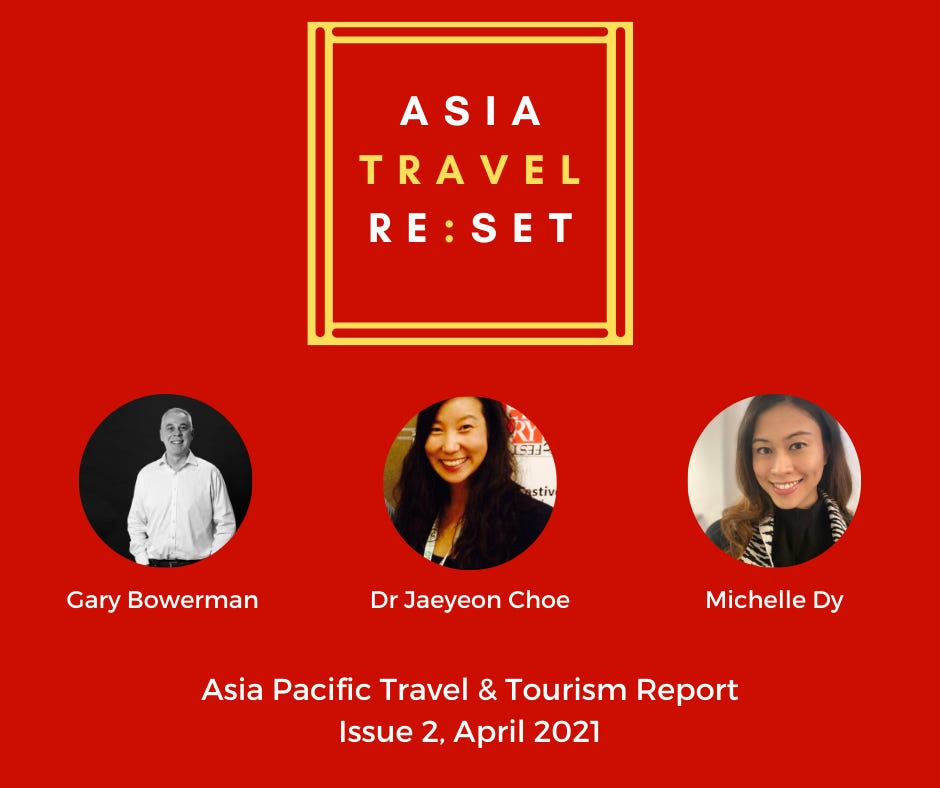Asia Travel Re:Set #38 - Asia Pacific Travel & Tourism Report, April 2021
This month's top travel industry talking points from China to Maldives, Russia to Sri Lanka and Thailand to Vietnam.
Hello. Welcome to our second monthly Asia Pacific Travel & Tourism Report…
I’m delighted to welcome back Dr Jaeyeon Choe and Michelle Dy for an April rewind.
Destinations featured include Australia, Bali, China, Malaysia, Maldives, Russia, Sri Lanka, Thailand and Vietnam.
Hot topics range from vaccine export bans, domestic airline innovations and QR code currencies to tourism target setting, business air travel and VFR bubbles.
If you like what you read, please share with a friend or colleague - either by forwarding the email or by using the button below. The power of sharing is underrated.
Thanks for being on board,
Gary
15 Travel Developments That Defined April 2021
Image courtesy of Auckland Airport
A VFR Travel Bubble Kick-Off
Beaming airport smiles among reunited family members. It was hard not to feel emotional at the photos from week 1 of the Trans-Tasman Travel Bubble.
Almost exactly 1 year after the concept was floated, Australia and New Zealand launched their highly anticipated inbound/outbound air corridor.
New Zealand residents have been able to travel quarantine-free to Australia since 16 October, but 2-way travel commenced on 19 April.
Initial bookings were reportedly dominated by those separated across ‘The Ditch’ from loved ones, plus business travellers. The upcoming winter season may see a scaling up of leisure travel, with Aussie ski fans heading to New Zealand’s South Island.
This is Step 1 to repair travel. On The South East Asia Travel Show, Simon Westaway, Executive Director of the Australian Travel Industry Council, said Australian tourism copped a loss of USD80-100 billion in 2020. He posited Singapore, Fiji, Vanuatu and the Cook Islands as possible partners for furthering a phased travel recovery.
And, then, it partly paused. A 3-day snap lockdown in Perth deactivated flights between New Zealand and Western Australia.
Will this jittery approach continue until vaccines are a travel pre-requirement?
Will Bali Win the Reopening Race?
While Thailand may, or very possibly may not, reopen Phuket to vaccinated travellers in July, Indonesia intends to reopen Bali by the end of July. The provincial government has confirmed it is game-on.
Vaccination roll-outs in Bali have sped up, with hopes of achieving herd immunity by July. Trips to the 3 “green zones” - Ubud, Sanur and Nusa Dua - will be organised by approved travel companies whose staff will monitor tourists’ movements.
Indonesia’s government says it is talking to Singapore, China, South Korea, Netherlands and the UAE to allow their nationals to visit the Bali “green zones”.
However, with low vaccination rates in some of these countries, we shouldn’t hold our breath. The Taiwan-Palau bubble hasn’t generated much momentum, and - as mentioned above - the Trans-Tasman bubble is, for now, a closed travel circuit.
Trust in international travel remains low among Asia Pacific governments.
Vaccine Nationalism & Export Bans
Countries that do not produce their own vaccines are fearful. Vaccine manufacturers are halting exports to prioritise domestic needs. This is not unexpected due to limited vaccine supplies worldwide - and initial overestimates of production capabilities.
Pundits have discussed extensively why vaccine nationalism is bad, so let’s highlight how countries are blocking exports of such precious commodities.
In the US, a 70-year-old law called the Defense Production Act is used to ban exports of critical raw materials used for vaccines. This is cited by India as the primary reason why it has temporarily halted vaccine exports for two months.
Meanwhile in the EU, no official export ban is in place, but there is a proposal to consider reciprocity and proportionality before authorising exports.
These developments, coupled with widespread inoculation hesitancy in Asia Pacific, should be taken as a signal by governments that they cannot pin their border reopening strategies on herd immunity alone.
Get a Jab, Get High
Speaking of vaccine hesitancy, a low registration rate for vaccination in Malaysia (currently 30% of the population) is concerning. Other countries are grappling the same problem, which has led to some interesting incentives to urge people to get a jab.
In China, promises of free food, supermarket vouchers and even cash prizes have been made. In Japan, touted benefits range from free bath salts to discounted taxi rides.
But probably the most creative reward so far is to be found in New York: “Joints for Jabs”. Get a vaccine shot and receive a free marijuana joint.
But do these strategies work?
According to this 2015 study, a penalty-based (‘stick’) approach was more effective in convincing people to get the influenza jab over incentive-based (‘carrot’) approaches. It must also noted that a stick approach did not involve making vaccinations mandatory.
Will governments start looking at penalties to induce higher vaccination take-ups?
Vaccine on Arrival, Anyone?
Maldives plans to offer COVID-19 vaccinations to tourists on arrival as part of its “3V - Visit, Vaccinate, and Vacation” strategy. Firstly, the local population will receive their two doses. To date, around 53% of the country’s population has received a first dose, which includes 90% of its front-line tourism workers.
So far in 2021, Maldives has received an impressive 370,000 tourists. Reopening to visitors in July saw it welcome 555,494 visitors in 2020. It is experiencing an increase in longer stay and ‘workcation’ tourists, who tend to be high net-worth individuals.
The vaccine visit news is interesting, as Indian media has reported that wealthy nationals have been travelling to the UAE to get their jabs.
Maldives is, of course, much closer - and offers the prospect of a luxurious short break.
Domestic Dominates China’s Airline Schedules
Seemingly bad news for countries seeking to build a travel bubble with China. The Civil Aviation Administration commenced the new airline schedules from March 28 through 30 October with a heavy emphasis on intra-China services.
Overall, 92,756 weekly flights are scheduled, up 10.7% year on year, some 90,460 of which are passenger flights and 2,296 cargo only.
This season will bring 322 new domestic air routes, operated by 38 carriers - with extra frequencies to/from 3rd and 4th-tier cities.
However, only 644 weekly international flights were announced, representing just 3% of the pre-COVID-19 era level.
An interesting battle is underway between Beijing’s 2 airports. The relatively new Beijing Daxing International Airport will operate 886 daily flights, while the stalwart Beijing Capital International Airport gets 1,079 per day.
China’s Domestic Tourism Surge
Travel confidence in China is rebuilding fast. Domestic tourism surged to near pre-pandemic levels during the recent Qingming (Tomb Sweeping) holiday.
Ctrip sold 232% more tickets to attractions for Qingming than during the same 2019 period - and boasted 40% more hotel bookings. One of the most visited destinations was Disneyland in Shanghai.
Meanwhile, local media reports that “the civil aviation sector is prepared for a travel rush” for the upcoming Labor Day holiday, starting on 1 May.
As more people get inoculated, a further dramatic recovery is expected for Chinese domestic tourism - which, of course, benefits from a 1.4 billion population.
The rest of Asia may struggle to follow the same recovery path, given a reliance on external travel source markets.
Domestic policymakers will need to get creative, and research shifting domestic tourist behaviours and emerging niche segments in order to entice local travellers to experience more homegrown destinations more often.
About the Team
Originally from South Korea, Dr Jaeyeon Choe is a researcher and consultant specialising in sustainable tourism development in South East Asia. She is co-editor of Pilgrimage Beyond the Officially Sacred: Understanding the Geographies of Religion and Spirituality in Sacred Travel, and keynoted at the Sustainable Tourism Development for South East Asia Conference in December 2019.
Based in Malaysia, Michelle Dy is a regulatory lawyer with extensive experience in policy research and public affairs across Asia-Pacific. She is also a published author of several academic journal papers and book chapters on cutting-edge issues in aviation.
Based in Malaysia, Gary Bowerman is Director of Check-in Asia, co-host of The South East Asia Travel Show and author of The New Chinese Traveler. Founder of Asia Travel Re:Set, he is a media commentator and speaker on Asian travel economics and trends.
‘Double Mutation’ Punctures India-Sri Lanka Bubble
In early April, India’s Ministry of Civil Aviation announced that a bilateral air bubble was near to agreement between India and Sri Lanka.
It was hoped that this would give a much-needed boost to Sri Lanka’s “tourism bio-bubble.” International tourists are subject only to a phased, and fairly flexible, quarantine, and are able to visit certain tourist sites at designated times.
However, India’s spiralling case surge - the 5-day moving average is 327,816 - and discovery of a ‘double mutation’ strain, saw Sri Lanka postpone the bubble launch.
This news is a disappointment to SriLankan Airlines Chairman Ashok Pathirage who noted “India was Sri Lanka's number one source of tourism” prior to the pandemic.
Tourism Board Target Setting is Back
After 13 months of posting heavily negative statistics that look backwards, a few travel authorities are projecting ahead once more.
While Maldives (realistically) targets 1.5 million visitors in 2021, Bali is aiming for “at least 1.5 million” arrivals once it reopens in “June or July.”
Having voiced a sliding scale of 2021 goals, from 6.5 million to 3 million, tourism bodies in Thailand have unplugged their algorithms as COVID-19 cases increase.
Surprisingly, Malaysia’s Minister for International Trade & Industry told a webinar this week that its aerospace industry could rebound to pre-pandemic levels “by 2022”.
Cambodia continues to ‘doomcast’. Arrivals will drop “by another 60%-70%” this year. Some 1.31 million visitors in 2020 were down from 6.61 million in 2019. Cambodia’s COVID-19 infections spike saw the 7-day average rise from 81 on 31 March to 425 on 22 April.
“We Are Not Prostitutes or Scammers”
In Malaysia, foreign visitors with expired social visit passes were ordered to leave the country on or before April 21, or face enforcement action.
Anyone who entered Malaysia before the Movement Control Order (MCO) began on 18 March 2020, and whose social visit pass had expired, were allowed to stay until this deadline without having to obtain prior approval or a special extension.
However, reports that some foreigners who stayed had become involved in prostitution or financial scams prompted Malaysia’s government to curtail the welcome.
This resulted in media quotes by banished travellers who were not involved in illegal activities saying they were sad to be leaving Malaysia in such circumstances.
By contrast, reports in April suggest Thailand wants overhaul its immigration rules “to make it easier for foreigners to live and work” in the country.
Thailand-Vietnam Travel Currency
As mentioned last month (Rethinking the Money Model in Cambodia), Central Bank Digital Currencies (CBDCs) will transform travel transactions.
China’s Digital Yuan may be rolled out for the 2022 Beijing Winter Olympics, and China is planning a pilot currency with Hong Kong, Thailand and the UAE.
Now, Bangkok Bank and the State Bank of Vietnam are testing a QR code payment format for tourists to use in each other’s country.
The mobile app can be drawn against Thai Baht and Vietnamese Dong, and will, according to Charamporn Jotikasthira, Executive Director of Bangkok Bank,
“Help customers reduce foreign exchange costs as they are able to pay in their own currency, which is cheaper than payment via credit or debit cards.”
More expansively, Nguyen Kim Anh, Deputy Governor of the State Bank of Vietnam, notes:
“The project marks an important milestone in the collaboration of ASEAN central banks in implementing ASEAN’s initiative on payment connectivity.”
One to watch!
Russia is an On-Radar Comeback Market
With China’s outbound air gates still locked and India battling world-record daily COVID-19 infections, tourism destinations are turning their eyes to Russia.
So far in 2021, Russia has provided 21.1% of visitors to Maldives, close to India’s 22.5%.
In April, Seychelles welcomed Aeroflot’s first direct flight from Moscow in 17 years.
Russia’s state carrier notes that, provided they carry a clean PCR test taken up to 72 hours before departure,
“Russian citizens can enter Seychelles visa-free, without any restrictions.”
It’s not long ago that countries were using that exact phrase to entice Chinese tourists.
Although tourism reopenings in Asia Pacific are thin on the ground, will we see Russian travellers become a priority target?
Perhaps for Phuket (big ‘If’) or Bali? Maybe Vietnam?
The Business Travel Debate Continues
“It will take years before business travel returns to pre-pandemic levels, if at all” is a widely accepted forecast. However, there are signs that this sentiment is changing.
A recent study by a travel experience provider concluded that business travel will not be fully replaced by videoconferencing technologies.
Alan Joyce, Qantas’s CEO, is also taking a bullish stance on business travel:
"There's a lot of talk about video conferencing taking a big hit on the business market. We've done our maths, and we looked at the level of the corporate market that's fly in, fly out, and its resource based, government based, construction and manufacturing based. Then we looked at the market that could be replaced by video conferencing, and its professional services and people having internal meetings. We think the net result will be a 13-15% drop in the corporate market size, but we actually think the SME market will be less impacted."
Encouraging signs are emerging. Sales results from Air New Zealand show domestic business travel has returned to 90% of pre-pandemic levels, exceeding all expectations.
Will business travel return in pockets, or will the recovery be broader?
Creative Airline Services For Local Flyers
All Nippon Airways introduced a new dining service for domestic tourists who miss flying. The dining cost could be cheaper, however. A meal is priced at $540 per person.
While the airline industry is facing entrenched and enduring challenges, several Asian airlines have launched creative services in domestic markets.
From “flying to nowhere” flights, speed dating at EVA Airlines and pop-up restaurants in parked aircrafts to improved award systems and better lounge experiences, airlines are innovating to offer new experiences to restless travellers.
These are mostly offered in trusted domestic contexts, though - without the wider world risks that dominate the travel debate.
Will short-term innovations boost flyer confidence when the airport gates reopen?
A World of Many Vaccine Passports?
While international travel is slowly becoming easier for vaccinated passengers in parts of the world, a universal vaccine certificate, database or app is proving elusive.
IATA has gained some traction for its digital health passport, yet various data management challenges exist to integrate it across countries and legal systems.
Some nations will prioritise their own domestic systems, while some will only accept travellers inoculated with vaccines approved for domestic citizens.
Meanwhile, IATA and the UNWTO are co-launching a destination tracker tool.
The imbalanced distribution of vaccines is creating inequality between those that do and don’t have the means to travel for a jab. If vaccinated US citizens visit countries in Europe or Asia with lower vaccination rates, for example, would locals feel their health is being compromised for the privilege of others?
Vaccinated people can still test positive, and find themselves in mandatory quarantine. Note the high-profile case of an Auckland Airport worker this week.
Various scientific studies show there is simply no way to travel ‘safely’ at the moment.
So many questions pertain. But a false sense of security could cause travel headaches for much longer than previously anticipated.
And, that’s a wrap.
The Asia Pacific Travel & Tourism Report will return on 30 May.
Until next Sunday, find me on Twitter, LinkedIn and the Asia Travel Re:Set website.
Have a great week,
Gary






